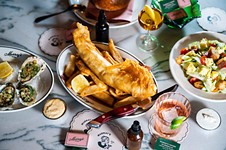Are DIY Chefs Biting Off More Than They Can Chew?
Five local foodies convene on kitchen DIY
By Melanie Haupt, 10:36AM, Sun. Mar. 9, 2014
In the case of this panel, so many cooks absolutely didn't spoil the broth.
A very late addition to the SXSW Interactive programming, "DIY: The New Culinary Movement" was part of the newly formed Food track. Moderated by Meghan McCarron, editor of Eater Austin, the panel consisted of Ned Elliott of Foreign & Domestic, Paul Qui of East Side King and Qui, and Rene Ortiz and Laura Sawicki of Fresa’s and the forthcoming Launderette and Angry Bear restaurants. What follows are the high points of the rain-drenched but very interesting and high-spirited conversation.
McCarron: You’ve all gained national acclaim for your work in the culinary world, and you’re on the front lines of what is new and exciting. People admire chefs because they are making things. At the same time, DIY emerged from the Seventies punk scene and is largely about rejecting mass production. It informs tech, music, art. How does this aesthetic apply to culinary? What comes to mind when you think of DIY and food?
Qui: For me, it was the freedom to fail and create from that failure.
Sawicki: We already know how to cook, so the DIY was learning how to run a business and creating a restaurant culture that’s our own. It’s all trial and error and learning from our peers.
Qui: I had to learn about plumbing and permitting and learning what I can get away with and what can wait.
Sawicki: We’re here to teach; we can teach staff how to cook, but also to be chef-individuals.
McCarron: Are you saying that at this point, back-of-the-house people need to have front-of-house experience?
Qui: Yes, at this point that’s part of the expectation.
Ortiz: It depends on the culture of the restaurant. Front of house and back of house is a collective culture. They should work together in a way that’s like a family.
Sawicki: We like to invite management to come into the kitchen to work a station so they know exactly what’s involved.
McCarron: Let’s talk about funding. Crowdfunding through platforms like Kickstarter seems to be the next level of DIY. What are your thoughts on that?
Elliott: Jonathon Sawyer [of Greenhouse Tavern in Cleveland] did a Kickstarter to secure loans because banks still see restaurants as a risky investment. I financed Foreign & Domestic through family and credit cards.
Ortiz: Crowdfunding is cheaper and friendlier money, especially with the rewards like T-shirts and koozies.
Sawicki: It’s great for the community. People want to give you their money!
McCarron: Another way restaurants seem to be embracing DIY is through things like making their own vinegars.
Qui: But it’s got to taste as good or better as the best vinegar you can get.
Ortiz: It has to be better than what you can buy. You can make bacalao in house, but I’d rather get it from Galicia, where they have a whole culture and expertise in making bacalao. You can’t compare your work to what they do. You have to respect the ingredients.
McCarron: These days you also see chefs aggressively partnering with farmers or having their own farms.
Sawicki: The farmers belong to that same DIY culture. The restaurant industry has grown so large so quickly that the farmers are still trying to catch up.
Ortiz: Urban farms don’t have the land to keep up with the kind of demand a restaurant has. We tried to have a farmer supply all our basil and cilantro and one 50-pound order wiped her out. Customers believe in and respect it when restaurants source from local farms, but it’s also very expensive to run a restaurant like that.
Elliott: A lot of it is educating staff and guests. Like, we’re in a 10-year drought. What do you expect with those conditions? You also have to define “local.” Is it 100 miles? One hour? All of Texas? The Gulf Coast?
Qui: There’s also a backlash to it. If I put a $50 half-chicken on the menu that the farmer sold to me for $20, I’m not going to make any money off that chicken. But I will put it on the menu every once in a while to test the waters.
Ortiz: There is a lot more worth with projects that are scalable than with a vanity project. Fresa’s is scalable. Investors love scale, so the growth potential is rad.
Sawicki: A big part of it for us has been learning how to engineer something that’s fast and functional. Nobody wants to wait in their fucking car for 30 minutes. But we also want it to be slow food because that’s who we are.
Ortiz: You learn how to maximize your dollar. How do you make food that’s super rad that people can take home and it tastes delicious?
McCarron: Let’s talk about social media, especially you, Ned. You’ve organized Indie Chefs Week for two years in a row now with chefs you have relationships with via Twitter.
Elliott: There’s a tipping point. Nobody gives a crap anymore about Twitter announcements about what’s on special. [Best Chefs lists by Gourmet and Bon Appetit] are focusing on these chefs with tons of PR money. This was a way to celebrate chefs who are doing really interesting things but don’t get the same kind of exposure. And the coolest thing about Twitter is when someone in Montana starts following you because they’re interested in what you’re doing.
Qui: I’m pretty random on Twitter. I don’t have a handle on it. I use it to post experiments or make connections with people I wouldn’t normally have contact with, and to share ideas.
McCarron: Wrapping up, what are the limits of DIY?
Sawicki: I’m having to do a lot of R&D at home. It keeps me going creatively even if it doesn’t translate into the restaurant.
Ortiz: It’s the yin and yang of high- and low-end restaurants. How do you find peace at work? You have to find a way to create a peaceful environment at work, because happy food is really good. It is definitely the age of the creator.
DIY: The New Culinary Movement
Saturday, March 8, BlackheartKeep up with all our dispatches from SXSW at austinchronicle.com/sxsw.
A note to readers: Bold and uncensored, The Austin Chronicle has been Austin’s independent news source for over 40 years, expressing the community’s political and environmental concerns and supporting its active cultural scene. Now more than ever, we need your support to continue supplying Austin with independent, free press. If real news is important to you, please consider making a donation of $5, $10 or whatever you can afford, to help keep our journalism on stands.
Carys Anderson, March 26, 2024
Richard Whittaker, March 20, 2024
March 8, 2024
South by Southwest, SXSW, SXSW 2014, SXSW Interactive 2014, Laura Sawicki, Paul Qui, Ned Elliott, Rene Ortiz, Meghan McCarron, Eater Austin, Qui, East Side King, Fresa's, DIY, Foreign & Domestic, Launderette, Angry Bear, restaurant










